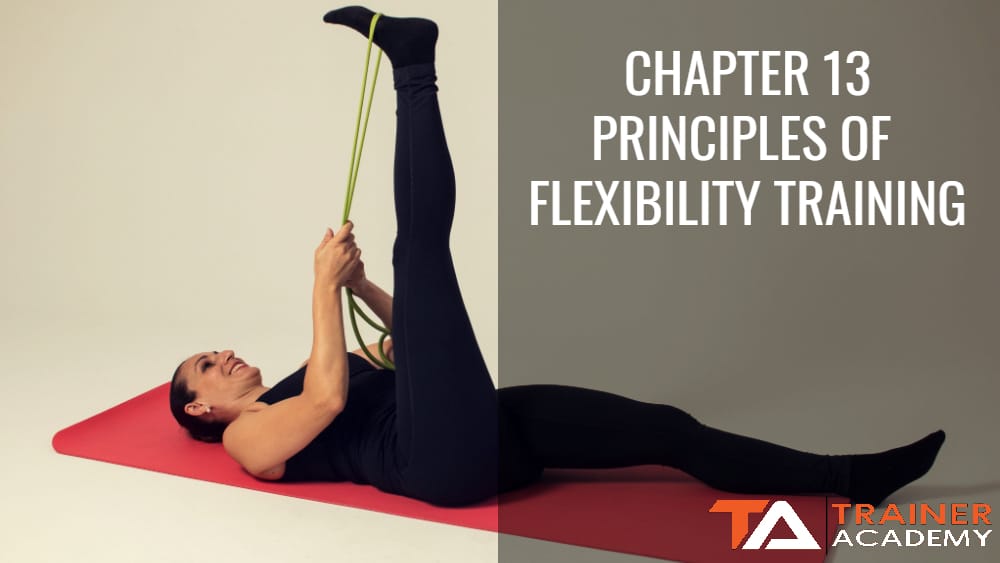Communication skills are vital for all fitness professionals. From closing sales with prospective clients, to instructing technique and guiding clients through behavioral changes, interpersonal communication is a constant aspect of being a great personal trainer.
Personal trainers, instructors, and coaches with good communication skills give vital information to their clients in training sessions and process feedback from those clients seamlessly. Effective communication between client and trainer continuously loops back and forth: the trainer provides information, and the trainee provides feedback, which allows the trainer to consider and make proper adjustments.
Fitness professionals need to keep that loop open by developing their communication skills to encourage discussion and openness. In addition, effective communication between coach and client expands outside of training. This chapter will cover communication skills that will provide success for a trainer.
The Importance of Communication Skills
Healthcare industry research shows that better relationships between clients and healthcare professionals lead to better health outcomes. Warmth, positivity, and clear listening lead to greater patient satisfaction with their healthcare professional.1
Communication has two components: Non-verbal and verbal.
Nonverbal Communication
Nonverbal communication describes messages that are conveyed outside of words. Information delivered by a trainer hunched over with a sullen face may be interpreted differently than that from a trainer standing up tall carrying a confident look on their face.
Nonverbal communication also includes the small things the body conveys as well, such as where an individual looks when they deliver information. For example, whether the individual is looking into the other person’s eyes or looking away when they are speaking makes a big difference in the effectiveness of the communication.
The way in which a fitness professional’s body language and other forms of nonverbal communication are interpreted by the client can make a huge difference as to whether a person signs up for or continues with training.
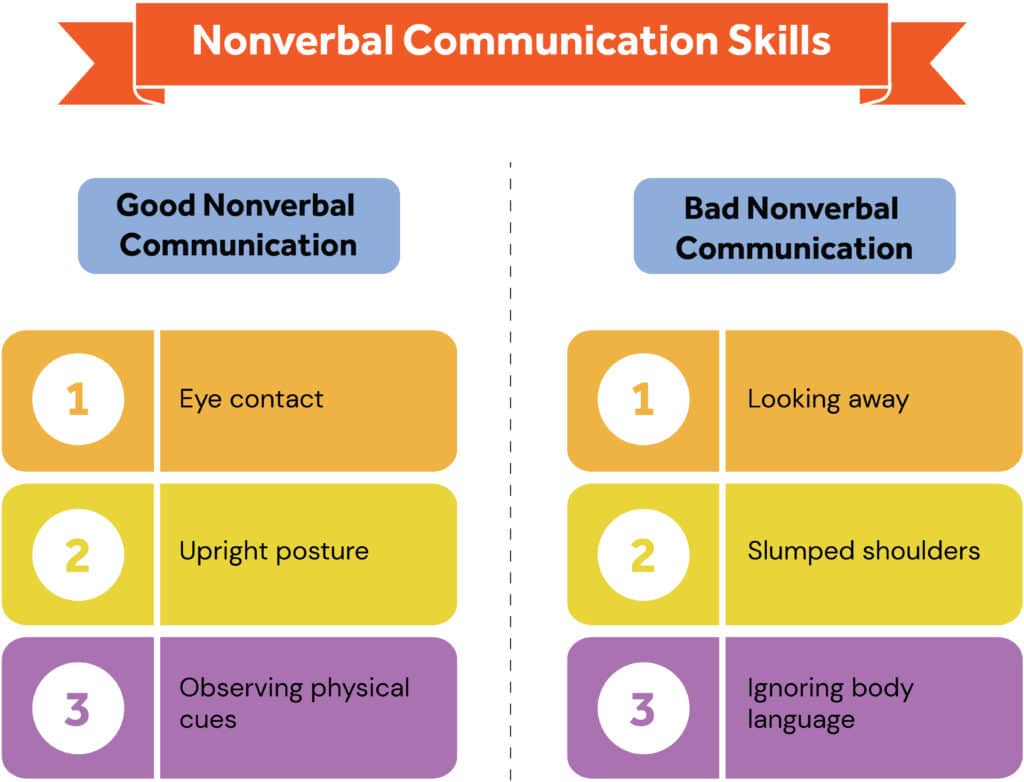
Active Listening and Verbal Communication
Active listening is a form of verbal and nonverbal communication that shows the other individual in the conversation that the coach is listening and taking into account what the client is saying. Active listening reduces defensive discussions and arguments, which improves both parties’ abilities to communicate openly.3
Active listening vitally builds up relationships and trust between individuals. Active listening includes nodding, repeating information, making eye contact, focusing on the other person as well as other facets like displaying care for the client.
By actively listening, the client can see that their coach cares about what they have to say and by extension, cares about them. Active listening has four main components that coaches will find effective:
- Listening to the spoken statements of the client
- Observing nonverbal communication
- Listening to the context of the client’s apprehensions
- Listening to the context of the client’s statements that may need to be challenged 4
The first part is simple enough: listen to the spoken statements of the client. This means the trainer pays attention to what the client is saying.
The next part, observing nonverbal communication, can take time to master. However, with some practice, fitness professionals can start to pick up on the subtleties of body language.
A client with a hunched back and arms crossed may be displaying apprehension and closed off to suggestion. In this case, the coach or trainer should focus on developing the relationship so the client feels like he or she can trust the coach.
The third part requires the trainer to pay attention to the spoken and the deeper emotional connotations the client is displaying. Often spoken words do not convey the entire picture and the client may not be able to communicate their apprehension effectively or they might be hiding something they’re embarrassed about.
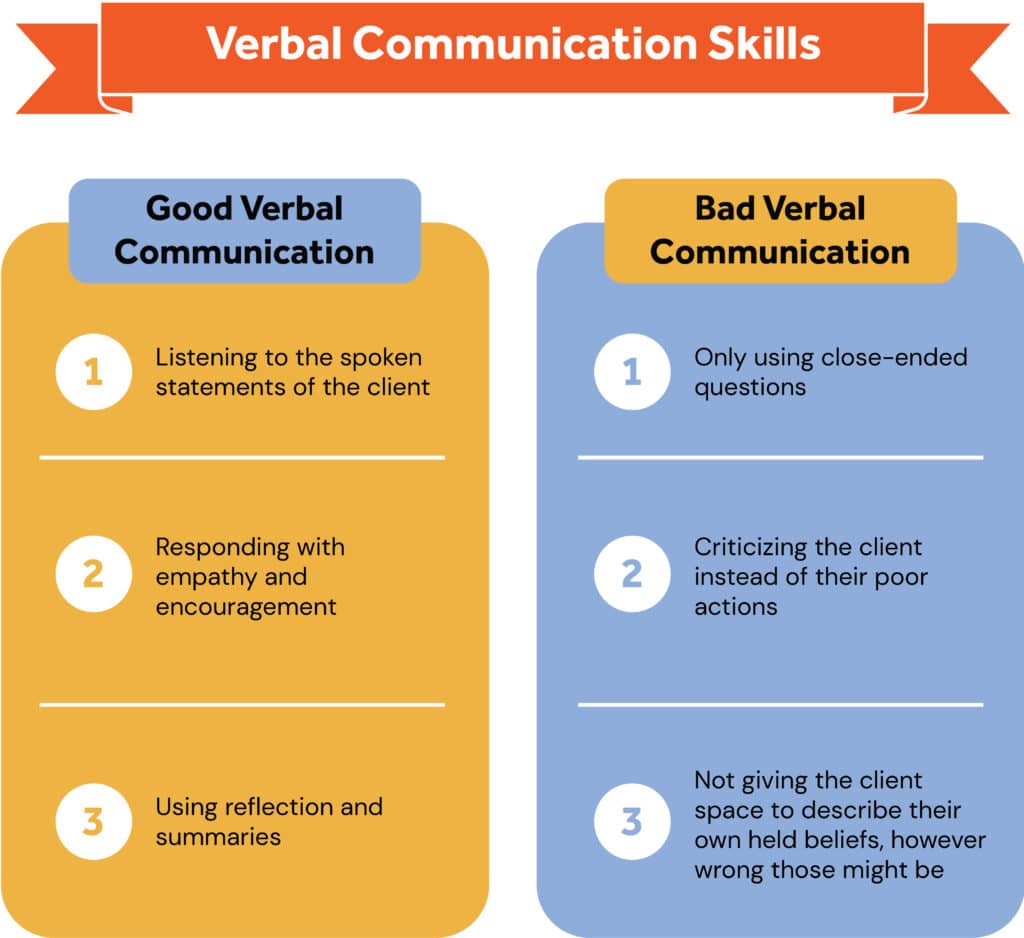
On the other side of that coin, sometimes, a trainer or coach needs to challenge an opinion of a client. When this happens, the client must feel seen and respected. The trainer should allow them to describe what they know, which will give the professional a chance to understand the client’s current beliefs.
Once the trainer positively affirms the correct beliefs, the coach can then address whatever myths or misinformation the client has described, during either that session or on subsequent workout days. Also, the trainer should give the client an opportunity to bring up their hesitations and concerns.
The next step of effective active listening requires empathy. The ability to share and understand each other’s feelings builds a more effective relationship. Both parties share. Both parties hear one another and feel heard.
When the coach shows they care about what their client has to say and feel, the client responds openly to the trainer. This enables both sides to speak directly. The trainer is the leader in this relationship, but the client should also be encouraged to take an active role as well.
A coach obviously needs to ask their clients questions but different kinds of questions can have a different effect on the relationship between client and coach. Close-ended questions, such as “what is your name” are unavoidable and provide important information to the coach.
However, open-ended questions allow for more engagement between the client and the coach. The kinds of interactions that open-ended questions allow for help build a healthy collaborative relationship that makes for a successful coach-client relationship.
How to Build Rapport
Rapport is a close relationship where both parties can communicate well. Developing rapport is a multifaceted process that uses important communication skills to help improve the client-coach relationship.
By creating rapport, a trainer and a client more easily address and solve problems that may arise. Building rapport requires a trainer’s empathy and self-awareness. To build and maintain rapport, a trainer should avoid arguments and instead use active listening and reflection, since arguments can be damaging to the trainer/client rapport.5
The coach needs to be able to incorporate previous experience when appropriate and understand when their previous experience does not apply.
Reflection is another powerful tool that involves expressing the meaning in a reply to the speaker to show them their words are understood. In the context of personal training, this offers a chance for the client to correct the trainer if they misunderstood the meaning of their words or a chance to confirm if the trainer is correct.
It may take some time for the trainer to become fluent with reflection, but in time, it can be a powerful tool. It should be noted that reflection, while a powerful tool, can be ineffective based on certain individuals.6
The natural evolution of reflecting is summarizing. Summarizing involves a series of reflections that highlight important parts of the conversation. It shows a deep understanding of the conversation and offers another chance for the client to correct or clarify any information.
A trainer must convey compassion and respect for the client’s differences while appreciating their similarities. A trainer should be able to discuss differences in opinion without arguing with the client and ultimately respecting the client’s opinion.
The trainer should also be able to discuss why something may not be working for the client in a manner that is still respectful and criticizes the actions of the client, not the client themselves. The trainer should motivate their clients with the knowledge they have accrued over time as well as leveraging their communication skills noted in this chapter to improve rapport.
The Initial Client Interview
Clientele will come into the initial interview with certain expectations. While many of those expectations will be different between clients, many overlap. The client expects their coach or trainer to be knowledgeable and confident, which is best conveyed through both verbal and non-verbal communication. In almost every case, the first impression will determine if the trainer will be allowed the opportunity to train their prospective client.
A good first impression has many components: making eye contact, smiling, a friendly greeting with a firm handshake followed by the trainer introducing themselves and then getting the prospective client’s name, using the client’s name, and displaying confident and open body language.
While most of these are self-explanatory, using confident and open body language may require practice from trainers who do not naturally possess this skill. Confident body language requires the trainer to be relaxed and stand up straight with their shoulders back and the head pointed forwards and the trainer should keep a smile or neutral facial expression.
Trainers who present the appearance of giving the client their full attention when they are speaking as well as refraining from closing their chest, as in crossing their arms in front of their chest, will be more successful. This last part is crucial for open body language. It displays to the client that the trainer is open and receptive to them and what they have to say.
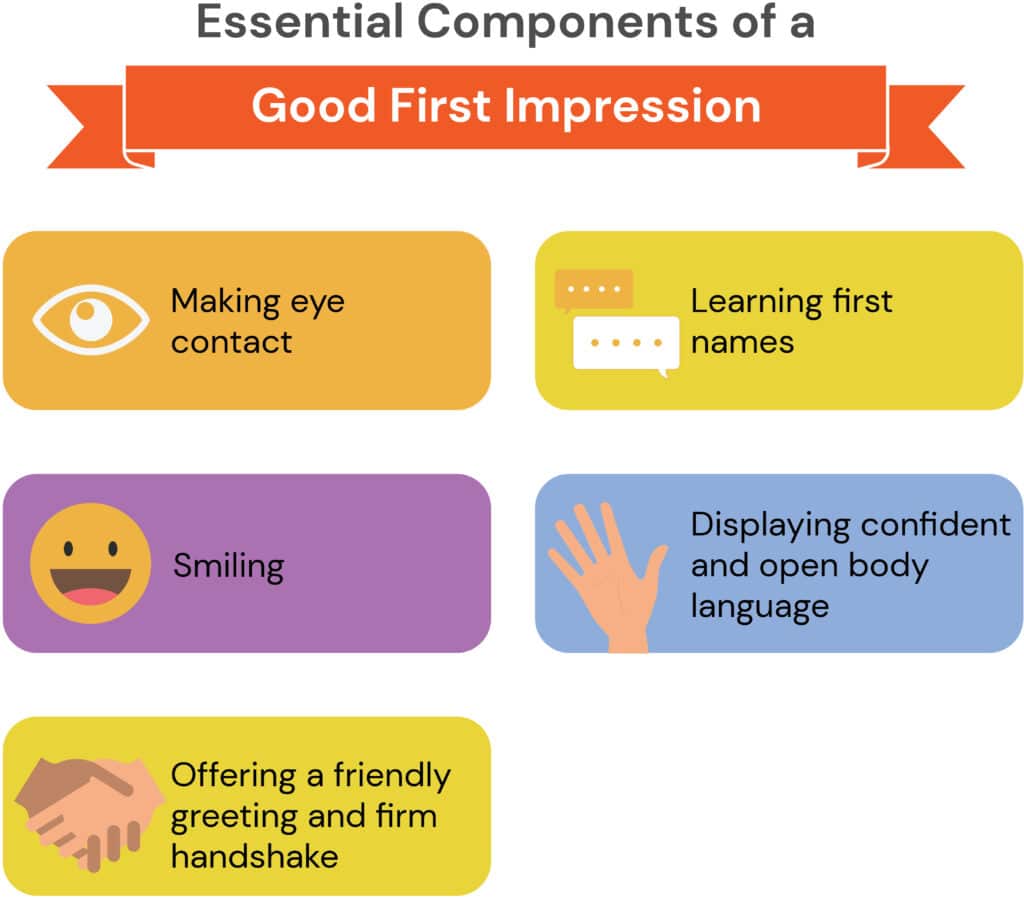
In addition to body language, clients will also notice the trainer’s appearance. While a suit or business casual wear is not necessary, being well-groomed and having clean clothes can have a positive impression on the client.
Throughout the interview, the trainer should be fully engaged in the conversation, asking both general and specific questions to better understand the client.
Examples of general questions include asking about injuries or conditions or how much experience the client has while specific questions fall along the lines of examining specifically what the client said.
Asking the client what kind of movements irritate their injury or what motivated them to start their fitness journey originally facilitates finding out information that will be integral to the training process.
This will show the client that the trainer cares enough to dig deeper and that the trainer listens to them.
If the client has no interest in sharing deeper information outside of training, the trainer should respectfully understand and continue to focus on health and fitness concerns.
Fitness Sales Process
Once a personal trainer or fitness coach establishes themselves, they need to be able to sell and market their services in order to be successful individually or as a part of a company or training facility. A trainer needs to be able to generate leads and take prospective clients through the sales process so that the trainer has clients to train.
Lead Generation
For many trainers, lead generation is the most difficult part of the sales process. Every personal trainer and coach at some point has to determine where they will find clients.
Some independent trainers may start by offering free training to close friends and family initially before charging them.
In terms of growth, some trainers may choose to rely on word of mouth. Many satisfied clients will promote their trainer without a push from their trainer. Other clients may need their trainer to communicate with them that it would be helpful if the client told their friends, family, and co-workers about their services. Overall, it’s advisable to wait until the client is satisfied with their progress and results before asking to be recommended.
Trainers who work in gyms, whether as a part of the gym’s team or as an independent contractor, are walking advertisements for their business. Some trainers may choose to offer complimentary services to promote their work. Some gyms may market their trainers through their front desk services while other trainers may join a professional network that may include other healthcare providers and retailers.
In a professional network, trainers will need to build relationships with others in the network so the other professionals can refer to the trainer and vice versa.
Finally, the last major method to generate leads is through the internet and social media. Having a significant presence on the internet, especially on social media, leads to opportunity. Producing content, such as videos, informative posts, blog posts, or whatever the trainer excels at making, will help grow their internet presence. It is paramount that all social media accounts and websites remain professional if they are used for personal trainer marketing.
Initial Contact
After a prospective client has taken interest in a trainer’s services, it is important to move on to the initial contact, which then leads to the initial consultation. This can take the form of an in-person consultation, over the phone consultation, or an online consultation, which can be through video calls, emails, text, or any other digital communication method. Keep in mind, the initial contact and initial consultations can happen at different times or all at once. The trainer should be prepared for either situation.
The initial contact is an opportunity for the trainer to make a positive first impression and to gather important information. As mentioned previously, there are many factors to consider when making a positive first impression, such as body language, a warm greeting, and making sure the prospective client feels cared for. In the online environment, especially in text or email consultations or initial contacts, body language no longer matters but nonverbal communication skills are still important.
Active listening, or reading in text format, will still apply, especially using open and closed questions along with reflecting.
Every trainer does this differently, but here are key points to keep in mind:
- The trainer should discuss the client’s fitness and health goals, physical limitations, and current experience and knowledge.
- Trainers should have an application process for prospective clients to fill out so a trainer will have that information on file before the initial consultation or for future reference as appointments and programming go on.
- Trainers must be aware of the limits of their scope of practice and refer to qualified professionals when appropriate.
Initial Consultation
The initial consultation comes after the initial contact, either immediately or as a follow-up appointment. The trainer should inform the client of when the consultation will be, what to wear and bring, and how much time the consultation will take. The initial consultation should take place in a relatively quiet area that allows for a reasonably private conversation.
If this is done online or over the phone, then it is less important to be secluded as long as it is confidential and communication is clear.
After greeting the client warmly, the consultation begins with the trainer-client agreement. This is when expectations are established or re-established. This could include monetary consequences for no-shows or cancellations for both parties to receive, a refund policy, and everything in between.
The client must understand what is expected from them and what the client can expect from the trainer. The trainer will keep records of all of these agreements and a copy should be sent or given to the client.
First, the trainer needs to discuss health and medical history with the client. Intake forms should include medical/health history sections in addition to basic information and fitness goals. Additionally, clients with serious underlying conditions should obtain medical clearance from a doctor.
If the trainer concludes a medical clearance form is needed, training should not start until the form is filled, signed, and provided by the client so the trainer knows what a physician deems acceptable for the client’s current state.
Informed consent is the next important step. From a legal, and ethical, standpoint, the client should know the potential risks and benefits of engaging in a guided exercise program. This provides the client an opportunity to understand what may or may not result from the training. Informed consent should be documented and the trainer and client should each have a copy.
Once all of the business, health, and legal information is documented and taken care of, the client’s goals should be revisited. As mentioned earlier, the client’s goals should have been discussed in the initial contact or put on the application form. The trainers should ask additional questions to clarify the client’s input on their form or to add context to provided information. This is a chance for the trainer to paint a clear picture of what the client wants, can and cannot do, and what the client will need to learn.
Physical Assessment and Trial Session
After the goals have been revisited, a physical assessment and trial session is the next step. While the documentation provides the trainer with initial information, a physical assessment may reveal other limitations or places to improve, such as mobility restrictions, cardiorespiratory deconditioning, and muscular imbalances.
Each assessment should be clearly explained to the client and demonstrated so the client knows how to perform the assessment and the trainer will have accurate assessment information.
Some trainers may decide to offer a trial session. This session may be free or at a reduced cost. The trial session will take the client through a training session to get a preview of what they can expect when they sign up for training.
At the end of the trial session, the fitness professional should immediately attempt to make the sale. If the client declines or does not commit to training at that time, a follow-up should be performed within the next few days.
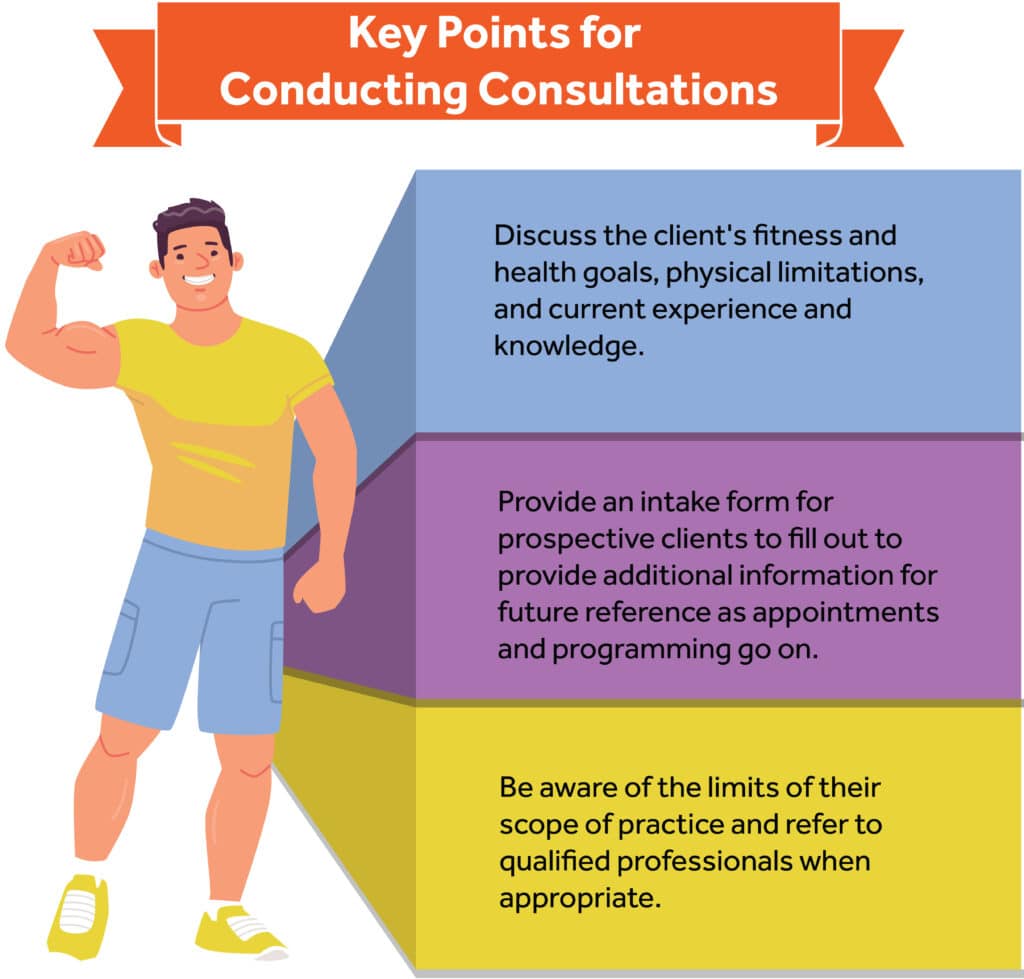
A well-executed initial interview using effective communication skills combined with a professional training experience during the trial session offers the best chance to close the sale and acquire a new client.
Follow Up
After both the initial consultation and the assessment/trial session, the trainer should follow up with the client by expressing appreciation for their time and effort.
A note, email, or call thanking the client for their time, expressing how good it is that they are taking a positive step in their health and fitness journey, and showing eagerness for the next session or training period will go a long way in keeping clients and reducing those who do not end up continuing their training with the trainer.
It is also helpful to remind the client of their next session and how to prepare for it. For online and in-person trainers, explaining what the next steps will look like will also be beneficial to keeping clients.
Closing the Sale
If all goes well, the client will communicate with the trainer after the trial period or the follow-up. At this point, it is time for the trainer to close the sale.
Closing sales is a major topic in any business and is the bottom line when it comes to actually earning money as a personal trainer.
Every fitness professional develops their own methods for closing the sale. Ideally, by the time the potential client is sitting down with pricing in front of them, the fitness professional will have learned enough about the client and established enough rapport that the sale comes naturally.
If the client has made it this far into the process, they are likely going to make a purchase. Nevertheless, there are still objections that the client may bring up.
Budget restrictions are one of the most common reasons a prospective client will cite when delaying making the final purchase.
It is certainly possible that the training sessions are entirely out of the person’s budget. However, if they mention budget concerns, the professional can direct them to the most affordable option while also reminding them of the value it will have on their life to reach their fitness goals. This is a good time to reference any pertinent information from the initial interview.
It is important for the trainer to be professional and understanding when a client decides not to go further with the trainer. The trainer should thank the client for their time and recommend them to someone who might be more suitable.
If the client does choose to continue working with the trainer, the trainer should offer gratitude and enthusiasm to work with the client further.
For trainers who are independent contractors or work on their own, it is also important not to undersell their training. Underselling their training can lead to clients devaluing what the trainer is offering. The price for independent trainers will vary depending on what is being offered, location, and competition.
In the case of a client who has already decided they will be purchasing training sessions before the final discussion, closing the sale does not involve pitching specific packages or overcoming objections. In this case, closing is just a matter of agreeing on payment methods, scheduling the sessions, and collecting payment.
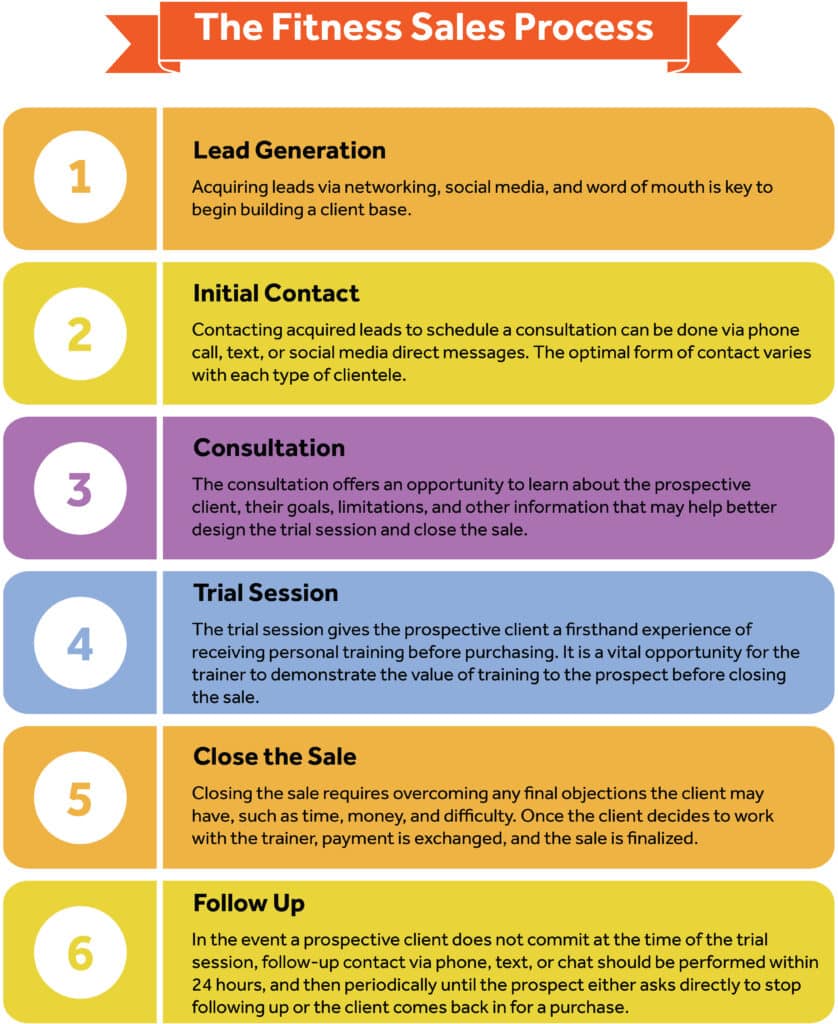
Summary
Communication skills are vital for every personal trainer to develop. Skills such as active listening and reflection help the client feel like they are being listened to when they talk to their trainer. Also, nonverbal communication such as body language can make or break the chance that a client will stick with that trainer.
Trainers need to be aware of verbal and nonverbal cues from their clients and themselves. The trainer who can marry communication skills with the sales process will have a strong opportunity to be successful.
The sales process includes being able to generate leads, conducting a successful initial consultation, providing a trial session if needed, following up with the client, closing the sale if the trainer can, or referring the client to a professional or resources that will better help them towards their goals.
Communication skills and a mastery of the sales process are key tools that all successful fitness professionals need to develop over time.
References
- Henry SG, Fuhrel-Forbis A, Rogers MA, Eggly S. Association between nonverbal communication during clinical interactions and outcomes: a systematic review and meta-analysis. Patient Educ Couns. 2012;86(3):297-315. doi:10.1016/j.pec.2011.07.006
- Mast MS. On the importance of nonverbal communication in the physician-patient interaction. Patient Educ Couns. 2007;67(3):315-318. https://doi.org/10.1016/j.pec.2007.03.005
- Cornelius, T. L., Alessi, G., & Shorey, R. C. The effectiveness of communication skills training with married couples: does the issue discussed matter?. The Family Journal. 2007; 15(2), 124-132.
- Davidson JA, Versluys M. Effects of brief training in cooperation and problem solving on success in conflict resolution. Peace Conflict. 1999;5(2):137-48
- Emmons KM, Rollnick S. Motivational interviewing in health care settings. Opportunities and limitations. Am J Prev Med. 2001;20(1):68-74.
- Weger H, Castle GR, Emmett MC. Active listening in peer interviews: the influence of message paraphrasing on perceptions of listening skill. Int J Listening. 2010;24(1): 34-49.


